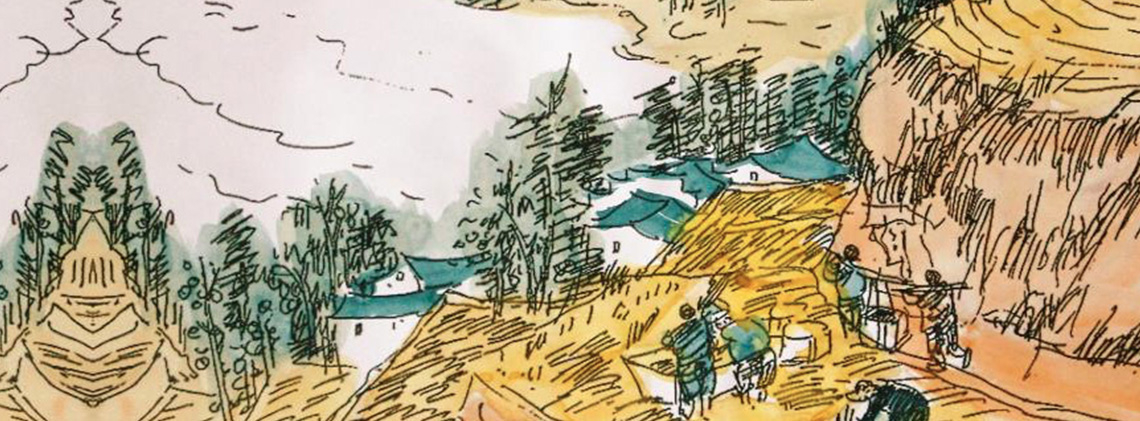
Speaking of Old Huizhou
Splendid
Chi Culture
Topic
Speaking of Old Huizhou
Huizhou lies in the mountainous region of southern Anhui province, along the border. The simple and honest mores of Huizhou are like a rare flower among the numerous gardens that are part of China’s intangible cultural heritage.
Praying for good fortune is a traditional folk activity with a long history. The prayers take many different forms including supplicating ancestors, worshipping the Buddha, praying for rain, and seeing in the new year. These activities show how the people seek good fortune from the spirits and dispel calamities. During traditional festivals and so-called “red events” such as weddings, local people also hold celebrations. These include dragon boat racing and diving which are done on the fifth day of the fifth month; the mid-autumn custom of “touching autumn” in which girls steal melons from their neighbors’ gardens as a way to ensure that when they marry they will give birth to boys; dragon dances which are performed to celebrate a bumper harvest and reunions; operas which are played during the New Year; and the colorful lantern shows during the Lantern Festival. In addition, Huizhou residents also have their unique way to mark major life events such as giving birth to a male child, welcoming a daughter-in-law, marrying off a daughter, and building a house.
Huizhou residents fully utilize the natural resources in the mountainous area to improve their life—they enrich their larders by catching fish and chukar partridges; they make straw sandals—a frugal way to protect their feet—and wear them when they fell trees in the mountains, or raft down a river. Timber has many advantages—the craftsmen can turn it into fireboxes or braziers to warm themselves and stave off the cold. Even beggars sing and dance to entertain the passersby when they beg for food or money.
Because there are more mountains than farmland, some residents are sent off as apprentices to learn a trade of handicraft to support their families. Wood and bamboo are so plentiful that the Huizhou carpentry and bamboo-working teams are the largest. Other professions are represented, such as bricklayers, stonemasons, tailors, and fine metal and iron smiths. These are itinerant tradesmen who work alone and travel amongst the villages. Some residents also work as cotton fluffers, brick carvers, tinkerers, and paper craftsmen. Once, these craftsmen lived closely among the people, and their varied handmade artistry fulfilled the needs of their fellow villagers. However, with industrialization and other changes in modern society, these trades are seen less and less often, if at all.
Taking advantage of geography and climate, Huizhou residents invented many ways to improve production and created a lifestyle that helped improve the environment. Some of their inventions are the human-powered or ox-powered waterwheel that was used to combat droughts; the large-scale, water-powered tilt hammer which was used for hulling rice or wheat; the small-scale treadle-operated stone mortar; the hand-operated oil press; manual tea production; and the wheelbarrow that was suitable for narrow winding mountain trails.
Surrounded by beautiful scenery, Huizhou is like a painting of a flowing landscape—the Xin’an River trackers, the prospectors panning gold, and the hunters on the mountain—they are all part of a living painting like the scroll Qingming shang he tu (Along the river during the Qingming Festival) coming to life. We can see the ferryboat that “the ferry landing deserted where a boat swings by itself” (A verse from Tang poet Wei Yingwu’s [737–792] poem “Chuzhou xijian” 滁州西涧 [On the Western Stream in Chuzhou]. Translated by Burton Watson, The Columbia Book of Chinese Poetry: from Early Times to the Thirteen Century, 1984.), watch the exciting performances of the theatrical troupes under the kerosene lamp, experience the unique portable barbershops carried on poles; enjoy the aromatic barley candy carried on the vendor’s back, or watch the long-storied flint knives being made.
During the Ming (1368–1644) and Qing (1644–1911) dynasties, most of the Huizhou residents engaged in commercial activities. At first, their main industries were lumber, tea, lacquerware, and the “four treasures of the studio”—writing brushes, ink stick, ink stone, and paper. Later, because of the new salt regulations, they established themselves in the salt industry and prospered. Their business reached its pinnacle during the Qing dynasty. Huizhou merchants’ footprints covered the Central Plain, both north and south of the Yangtze River.
Many exceptional skills were passed down from generation to generation in the Huizhou region. One custom, commonly done by older women for brides, is removing fine facial hair using a cotton thread. Other skills include how to castrate livestock and poultry, the special technique and secret tools for shoeing a horse, the simple and easy way to catch fish using a lift net attached to bamboo poles; and the amazing skills of the bold and masculine lumber transport workers—riding the waves and risking the rapids. These skills, like antiques, are all sealed in the treasure house of history. Some of the terms for these old skills have even become the subject of nursery rhymes.



